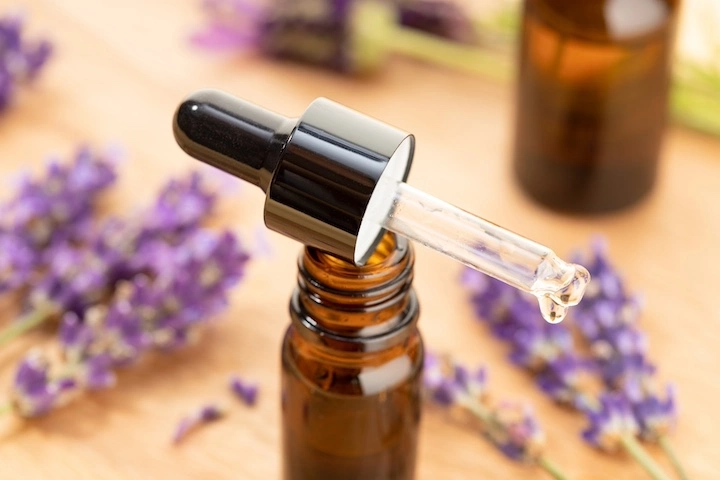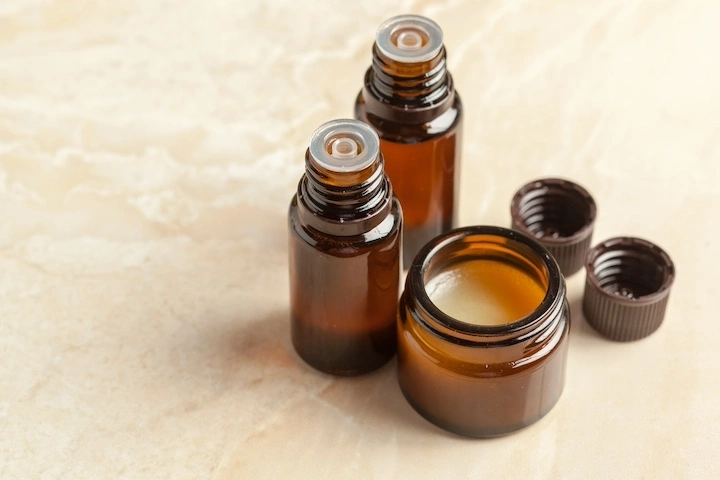
15 avril 2024
Essential oils are increasingly popular and used for their numerous aromatic, cosmetic and even therapeutic properties. Concentrated in active molecules, they are far from being innocuous and can in certain cases provoke undesirable reactions, notably allergies.
This phenomenon remains little known to the general public, who tend to minimize the risks associated with the use of essential oils. However, it is essential to be well informed about their potential side effects in order to use them with complete peace of mind and without danger.
Whether you are a professional who uses essential oils in your products or an individual, this article aims to provide you with all the keys to understand, identify and prevent allergies to essential oils. Complete information, expert advice and essential precautions: everything you need to know to tame these powerful natural products with confidence.
What you will find in this article:
Here are the 3 main takeaways from this article on allergies to essential oils:
- Certain essential oils contain allergenic molecules that can provoke reactions in sensitive people. The chemical families most at risk are terpenes (limonene, linalool), aldehydes (cinnamaldehyde) and certain alcohols. Citrus, lavender, cinnamon and clove essential oils are among the most allergenic.
- To know if you are allergic to an essential oil, you should always do a preliminary skin test by applying 1 drop of diluted essential oil to the crook of the elbow and checking for no reaction after 48 hours. Symptoms of an allergy can be cutaneous (redness, itching, eczema), respiratory (rhinitis, asthma) or even general in severe cases.
- To use essential oils while limiting the risk of allergy, certain precautions must be respected: always dilute them in a vegetable oil, be vigilant with oils known to be allergenic, do not apply them to mucous membranes, limit the duration of use to 3 weeks. People with an allergic background should be extra cautious and seek medical advice.
In summary, allergies to essential oils are a reality that must be kept in mind in order to use them safely. Carefully choosing your oils, testing your tolerance beforehand and respecting the rules of good use allows you to benefit from their advantages while limiting the risks of undesirable reactions.

I. Understanding allergies to essential oils
A. What is an allergy?
An allergy is an excessive and inappropriate reaction of the immune system to a normally harmless foreign substance, called an allergen. In most people, these substances do not cause a reaction. But in allergic people, the immune system mistakenly identifies the allergen as a threat and triggers a response to defend against it.
Upon first contact with the allergen, the body produces specific antibodies called Immunoglobulin E (IgE). These antibodies attach to certain immune cells, mast cells and basophils. During subsequent exposures, the allergen is recognized by the IgE, which activates the mast cells and basophils. These cells then release inflammatory substances such as histamine, responsible for the symptoms of the allergy.
This hypersensitivity reaction can manifest itself through various symptoms depending on the organ affected:
- On the skin: redness, itching, eczema, hives
- In the eyes: tearing, conjunctivitis
- In the nose: sneezing, runny nose, congestion
- In the bronchi: cough, breathing difficulties, asthma
- Digestive: nausea, vomiting, diarrhea
- Severe generalised reaction: anaphylactic shock (medical emergency)
Allergens can be of very varied nature:
- Aeroallergens: pollens, animal hair, dust mites, molds
- Food allergens: milk, egg, peanut, nuts, fish, shellfish...
- Contact allergens: nickel, perfumes, preservatives, latex...
- Insect venoms: bee, wasp, hornet...
- Medications: antibiotics, anti-inflammatories...
Certain chemical substances present in essential oils can also be allergens in sensitive people and trigger skin or respiratory reactions. This is notably the case for terpenes (limonene, linalool), aldehydes or certain alcohols.
In summary, an allergy is an exaggerated and specific immune response of the body to a foreign substance. It involves the production of particular antibodies, IgE, which trigger an inflammatory reaction responsible for various symptoms. Many natural or chemical substances can be allergens, including some components of essential oils.
B. Allergens in essential oils
Although 100% natural in origin, essential oils are far from harmless. They contain a multitude of complex biochemical molecules, some of which are known for their allergenic potential.
Among the chemical families most often implicated, we find:
- Terpenes, and notably monoterpenes such as limonene, omnipresent in citrus zest essential oils (Lemon - Citrus limon -, Sweet Orange - Citrus sinensis -, Bergamot - Citrus bergamia -...). It is the most frequently identified allergen.
- Terpene alcohols such as:
- linalool, a major component of Lavender, Rosewood (Aniba rosaedora var. amazonica) or Geranium (Pelargonium graveolens) essential oils;
- geraniol, a molecule present in Java Citronella (Cymbopogon winterianus), Geranium (Pelargonium graveolens) and Rose (Rosa x damascena) essential oils;
- and citronellol, present in Rose (Rosa x damascena), Java Citronella (Cymbopogon winterianus), Lemon Eucalyptus (Eucalyptus citriodora) and Geranium (Pelargonium graveolens) essential oils;
- Aromatic aldehydes such as cinnamaldehyde, present in large quantities in Cinnamon bark (Cinnamomum verum) essential oil.
- Phenols including eugenol, found in Clove (Eugenia caryophyllus) essential oil.
- Certain sesquiterpenes such as alpha-pinene, a well-known allergen of pines and firs.
These molecules are not dangerous per se but can, even at low doses, trigger an excessive reaction of the immune system in predisposed people. The risk of sensitisation depends on several factors such as each person's atopic background, the concentration of allergens in the essential oil and the route of administration, with the skin being the most exposed.

C. Prevalence of allergies to essential oils
While it is difficult to have precise figures, allergies to essential oils are far from anecdotal. It is estimated that about 1 to 3% of the general population is affected by a contact allergy to these substances.
But this risk is higher in certain categories:
- People with a personal or family history of allergy, eczema, asthma... An atopic background promotes sensitisation to essential oils.
- Children, whose immune system is still immature. Caution is advised before the age of 3.
- Pregnant women, due to hormonal and immune changes related to pregnancy.
- Professionals frequently handling certain allergenic essential oils such as aromatherapists, estheticians or physiotherapists.
A study conducted in 2010 on more than 1500 patients consulting in dermatology showed that 1.1% of them had an allergy to at least one essential oil, with linalool being the most frequent allergen. Among aromatherapists, this figure rises to nearly 10%.
With the growing enthusiasm for essential oils, both in the domestic sphere and in cosmetics, cases of allergies are likely to increase in the coming years. Hence the importance of clear information on the potential risks and precautions for use of these highly concentrated substances.
II. Identifying the most allergenic essential oils
Although all essential oils can potentially cause allergic reactions, some are considered more at risk due to their composition rich in allergenic molecules.
A. Essential oils rich in terpenes
Citrus zest essential oils such as Lemon (Citrus limon), Sweet Orange (Citrus sinensis), Bergamot (Citrus bergamia) or Mandarin (Citrus reticulata) contain high amounts of limonene, a highly allergenic terpene. Fine Lavender (Lavandula angustifolia) essential oil is also rich in linalool, an allergenic terpene alcohol.
B. Essential oils rich in aldehydes
Cinnamon bark (Cinnamomum verum) essential oil contains up to 75% cinnamaldehyde, an extremely irritating and allergenic aromatic aldehyde for the skin.
Other essential oils such as Cumin (Cumimum cyminum) or Fennel (Foeniculum vulgare) are also to be monitored for their aldehyde content.
C. Other high-risk essential oils
Among the essential oils known to be allergenic, we can also mention:
- Ylang-Ylang (Cananga odorata), due to its linalool content
- Clove (Eugenia caryophyllus), rich in eugenol
- Peppermint (Mentha x piperita), containing menthone
- Thyme thymol (Thymus vulgaris) and Compact Oregano (Origanum compactum) containing linalool and limonene
- Rosewood (Aniba rosaedora var. amazonica), which contains linalool
- Palmarosa (Cymbopogon martinii) due to its geraniol and linalool content
D. Focus on the best tolerated essential oils
Conversely, some essential oils are considered to be little or not allergenic, such as Roman Chamomile (Anthemis nobilis), Italian Helichrysum (Helichrysum italicum), Ravintsara (Cinnamomum camphora) or Niaouli (Melaleuca quinquinervia). They constitute good alternatives for people with sensitive skin or an allergic background.

III. Recognizing the symptoms of an essential oil allergy
An allergy to essential oils can manifest itself in different ways depending on the mode of exposure (cutaneous, respiratory, oral...) and the sensitivity of the person.
A. Skin reactions
On the skin, the most frequent symptoms are:
- Redness, itching, burning sensations
- Contact eczema, hives, swelling
- Appearance of pimples, vesicles
These skin reactions usually appear within hours of applying the essential oil.
B. Respiratory symptoms
Inhaling essential oil vapors can also trigger respiratory symptoms in allergic or asthmatic people:
- Breathing difficulties, chest tightness
- Cough, rhinitis, sneezing
- Asthma attack in severe cases
C. What to do in case of an allergic reaction?
If you experience symptoms after using an essential oil, it is recommended to:
- Immediately stop using the product
- Clean the exposed area with a vegetable oil
- Take an antihistamine to relieve symptoms
- Consult a doctor in case of a severe reaction (breathing difficulties, mucous membrane involvement...)

IV. Preventing allergies to essential oils
The best way to avoid the inconvenience of allergies is to take a few precautions before using an essential oil.
A. Choosing your essential oils carefully
Favour essential oils that are:
- Of quality, from organic farming
- 100% pure, authentic and natural, without the addition of synthetic molecules
- Whose composition is guaranteed (chemotyped), notably thanks to the regulatory documents and certificates of analysis provided
- From trusted suppliers or brands
Landema.com proves to be a supplier of choice: Landema essential oils are pure and authentic, largely certified organic, COSMOS or FFL and we guarantee their origin and quality.
B. Doing a skin test before use
Before using an essential oil for the first time, it is essential to perform a skin tolerance test:
- Apply 1 drop of essential oil diluted in 1 or 2 drops of vegetable oil to the crook of the elbow
- Massage to penetrate
- Wait 48 hours while observing for any reactions (redness, itching...)
- If there is a reaction, avoid using this essential oil
C. Respecting precautions for use
To reduce the risk of allergy, strictly follow the recommendations:
- Always dilute essential oils in a vegetable oil before skin use
- Respect the recommended doses and durations of use
- Avoid application to mucous membranes, eyes, nose, ears
- Take regular breaks between treatments (a minimum of one week for 3-week treatments)
D. At-risk populations
Increased vigilance is necessary for certain more vulnerable populations:
- People with an allergic background or asthma
- Pregnant women and young children
- Professionals exposed to essential oils
In these cases, it is preferable to seek the advice of a doctor or aromatherapist before use.

© Landema - Biolandes Group
V. Regulation and labeling of allergens
A. The list of allergens to be labeled
Since 2009, European regulation EC 1223/2009 requires cosmetic product manufacturers to mention on labels the possible presence of 26 allergens in their products, including 12 that are present in essential oils:
- Limonene
- Linalool
- Citral
- Eugenol
- Geraniol
- Cinnamaldehyde
- ...
Since July 26, 2023, this regulation has been amended by regulation EC 2023/1545, and the list of allergens to be labeled has been increased to 82. It should be noted that it includes not only molecules but also essential oils such as Ylang-ylang (Cananga odorata), Bay laurel (Laurus nobilis) and Peppermint (Mentha x piperita).
In most cases, essential oil suppliers provide an Allergen Certificate. At Landema.com, this certificate can be directly downloaded from the product sheets as soon as you are logged into your customer account. To create your customer account now, go to https://landema.com/register
In the food products sector, there is also since 2011 a requirement to label 14 allergens (INCO regulation 1169/2011), but essential oils are not part of it.
B. Concentration thresholds and exceptions
For cosmetic products, these allergens must be labeled as soon as their concentration exceeds a certain threshold, set at 0.001% in leave-on products and 0.01% in rinse-off products.
The IFRA (International Fragrance Association), which plays an important role in the perfume industry, sets in its Code of Practice maximum concentrations not to be exceeded for certain allergenic components of essential oils. For example:
- Limonene: 0.1 to 20% depending on product categories
- Linalool: 0.1 to 20%
- Eugenol: 0.2 to 0.5%
- Cinnamaldehyde: 0.02 to 0.05%
As for the use of essential oils as food flavorings, the usage dose is set at a maximum of 2%.
However, some exceptions exist, such as for essential oils naturally present in food products.
C. What it changes for the consumer
These regulations allow consumers to be better informed about the composition of products and to more easily identify the possible presence of allergens. They can thus make informed choices, by avoiding products containing substances to which they are allergic.
For a serene use of essential oils
Essential oils are powerful natural products that deserve to be used with caution and discernment. Although rare, allergies represent a risk that should not be neglected, especially since their symptoms can be disabling.
By being well informed about the risks of allergy, by choosing quality essential oils, by testing your tolerance beforehand and by respecting the advice for use, it is quite possible to serenely enjoy the virtues of essential oils without danger, whether for professional or personal use.
By following the advice given in this article, you will have all the keys to tame essential oils with complete peace of mind:
- Identify the essential oils most at risk for your profile or that of your customers if you are a professional
- Systematically perform a skin test before use
- Strictly follow the precautions for use (dilution, dosage, duration...)
- Be particularly vigilant if you are part of an at-risk population
- Trust quality essential oils, well labeled and traceable
Do not hesitate to seek advice from your doctor, your aromatherapist or Landema.com if in doubt.
Thus informed, you can fully enjoy the countless benefits of essential oils, without fearing possible inconveniences related to allergies. A serene use, with full knowledge of the facts!
To learn more about the subject, you can consult these reference sites:
Items that could
interest
Our essential oils
will simplify your life
FAQ
As a customer of the Landema website, did you know that we also have a physical store? If you live in the Landes, in New Aquitaine or are planning to stay there, do not hesitate to visit us! We are located in Le Sen, on the Biolandes site, very close to Labrit, Roquefort, and Mont-de-Marsan, in the heart of the Landes de Gascogne regional natural park.
Essential oils are natural aromatic substances extracted from plants. They are often used in aromatherapy for their health and wellness benefits. Essential oils can be extracted from different parts of plants, such as leaves, flowers, barks, roots or seeds. The use of essential oils dates back to ancient times, where they were used for their medicinal properties and to perfume cosmetics and skincare products.
Landema invites you to discover our product range composed of essential oils, absolutes, vegetable oils, macerates or hydrosols. Our catalog will grow over time, stay informed by subscribing to our newsletter.
We invite you to discover our practical guides and our blog where you can discover our advice and our cases of use of essential oils.
Your wishlist
You must be logged in to post a comment.
Login, or create an account
There is no comment for this article yet